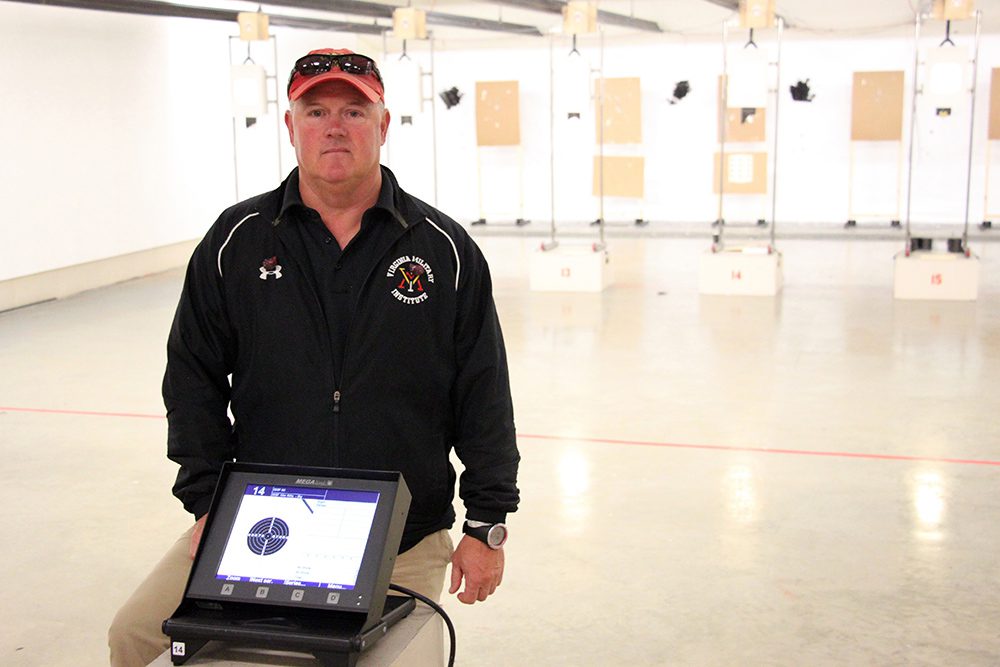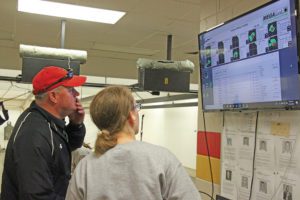Bither: Pulling Double Duty

Lt. Col. Bill Bither on the air rifle range in Kilbourne Hall. He serves as both the NCAA men’s and women’s rifle team coach and on the commandant’s staff as the director of Corps marksmanship.

Lt. Col. Bill Bither on the air rifle range in Kilbourne Hall. He serves as both the NCAA men’s and women’s rifle team coach and on the commandant’s staff as the director of Corps marksmanship.
Unique among VMI’s NCAA coaches, the head rifle coach is also a vital member of the commandant’s staff. Since 2011, Lt. Col. Bill Bither has been serving in these dual roles: Coach of VMI’s NCAA Division I men’s and women’s rifle teams, while also serving as the director of Corps marksmanship.
The sport he coaches is also unique. Unlike the classic image of NCAA Division I athletes straining, striving – and sweating – their ways toward goals, baskets, runs and finish lines, control is the name of the game for rifle athletes.
Rifle competition sounds deceivingly simple: Pick up the firearm, aim, fire. There is, however, much more to the discipline than meets the eye. Bither begins with the essentials. “I could probably write a two or three page list of things you need to do before you squeeze the shot,” he said, going on to explain that the first things he teaches “are the fundamentals of good marksmanship.”
These fundamentals involve significant patience and control on the athlete’s part: Breath control, trigger control, aiming – which is really twofold: Sight picture and sight alignment, hold control and follow through. The last step – follow through – is essentially holding the same shooting positon for a few seconds after squeezing the trigger. If the athlete doesn’t continue holding the firing position for those few seconds, the shot has good chances of going astray.

The rifle teams opened the 2019 season beating The Citadel at the home range in Kilbourne Hall Sept. 21. Bither, left, checks scores on the Megalink screen during the smallbore portion of the match.
Bither’s athletes initially spend more time practicing fundamentals without their firearms than with them. “If you start out wrong, you’re just reinforcing bad habits,” he said. By practicing the basics without the firearm, he can weed out any incorrect positioning and tendencies before they become routine.
A well-trained rifle athlete can calmly combine all the fundamentals, squeezing the two-stage trigger and taking up the initial slack, then timing the final trigger squeeze with sight alignment and sight picture, finally breaking the shot “in a perfect timing sequence.”
While rifle athletes benefit from physical training regimens, particularly core exercises, Bither feels that “every bit” of the allowed practice time is best spent practicing fundamentals and actually shooting. “We depend on the Corps and the ROTC” physical training time, he said, noting that he’s not concerned about physical training for his rat athletes “because they’re getting smoked every day.”
Aside from learning – and practicing – fundamentals, Bither’s teams have some assistance from their gear. They wear a stiff, somewhat uncomfortable suit and boots, designed to minimize movement while providing a measure of stability. There is a thick, rubber glove for the non-trigger hand that helps each athlete support the rifle, particularly while in the standing position. The glove also decreases the athlete’s skin – and pulse – contact with the rifle. There is also a small table, called an offhand stand, beside each firing lane where athletes can set rifles to both rest and reload. For the “extremely uncomfortable” kneeling position, athletes tuck a kneeling roll underneath their feet to add support. Rifles themselves have slings to hold the weapon tight, along with butt hooks designed to tuck snugly into the armpit area.
NCAA rifle competitors can use two types of firearms: Smallbore and air rifles, both of which are single shot firearms. For beginners, Bither encourages picking one type of firearm and getting comfortable with it for a year or two. Experienced athletes generally shoot both types of rifles in competition. After a 15 minute warmup period when athletes shoot as many practice rounds, or “sighters,” as desired, the timed competition begins. For smallbore, competitors have one hour and 45 minutes to shoot 20 rounds each from three positions: Kneeling, prone and standing. For air rifle competition, each athlete has one hour and 15 minutes to fire 60 rounds – all from a standing position.
“Coach Bither absolutely keeps his shooters’ noses to the grindstone. He knows exactly what each shooter needs from him as a coach to be successful."
Andrea Doehler Mother of team member Cadet Ben Doehler ’21
Rifle matches are calm events. At the first match of the 2019 season – a win over The Citadel – cadets, parents and coaches quietly conversed in the hallways outside the Kilbourne Hall range. Inside the range, everything happens in muffled tones. Cadets shooting were in their lanes, intensely concentrated on their targets and positions. Bither’s influence is felt in every aspect of the rifle team, said Andrea Doehler, mother of team member Cadet Ben Doehler ’21.
“Coach Bither goes to great lengths to foster an environment that ensures his shooters feel at home on the rifle range. He goes to similar lengths to make sure that visiting rifle teams and their friends and families feel just as welcome when they are at VMI,” she said. This was in evidence during the match versus The Citadel Sept. 21, 2019: Coaches of arguably one of NCAA Division I’s biggest rivalries, quietly discussing results – during the competition. A factor in the rifle team atmosphere is the athletes’ preparation prior to matches, Doehler noted.
“Coach Bither absolutely keeps his shooters’ noses to the grindstone. He knows exactly what each shooter needs from him as a coach to be successful,” she said. “It is quite something to watch him adapt his coaching style from shooter to shooter. Some shooters might simply need a hand signal – maybe a thumbs up. Others might need verbal reinforcement. In any case, Coach Bither knows what coaching style each of his shooters needs in order to be successful.”
One of the tools he uses to monitor progress is an electronic targeting system called Megalink, which provides precision results. Following each shot, each athlete sees near-instant results on an individual video monitor system. There is also a large-screen version for coaches and spectators behind the firing line. “Once the round pierces the bullseye it will give exact shot placement based on sound systems on the monitor. It’s almost like a video game where you’re actually shooting live ammunition,” Bither explained.
Piercing the bullseye means sending a round 50 feet downrange into a 4-centimeter black bullseye for smallbore, and from 10 meters for the air rifle. “The target won’t register unless you’re inside that black ring,” Bither said. “It takes an incredible amount of precision and concentration to put a round inside that black bullseye.”
For scoring, a 10.9 on the Megalink screen indicates a perfect shot. Decimals are not included in final match scores, meaning 600 is a perfect match score.
Each team needs five athletes to compete, and the top four scores count toward the team score. Bither tries to keep 22-24 cadet-athletes on the team roster. The women’s team is required by Title IX, and the other team can be either men’s or coed. While some athletes come to Bither already experienced in the discipline, he also heavily scouts the rat classes for potential rifle team members. “I really start recruiting during STP [Summer Transition Program],” he said. The hours Bither spends on Corps marksmanship instruction pay dividends to the rifle team, since he often spots – and recruits – potential rifle athletes during this instruction.
Per NCAA regulations, VMI’s rifle program allowed 3.6 grants, or scholarship equivalencies, per team. The teams are not currently fully funded, but Bither is “grateful for every penny and dime we get.” He uses a merit-based system to award available funds to athletes who are competitive, are earning good grades and have longevity on the team. Many rifle athletes are also ROTC scholarship cadets who go on to commission into the military following graduation.
ROTC brought Bither to VMI initially as an Army ROTC instructor from 1996-99. He then served a repeat tour in Army ROTC as the executive officer from 2001-05. Following his retirement, he worked as a government contractor until his current position opened.
